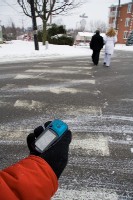Geocaching
Sports Trivia For one day every April treasure hunters put aside their competitive instincts and join together to mark International Cache in Trash Out day. Participants in the game of Geocaching join in a global effort to clean up parks, woods and beaches.
For one day every April treasure hunters put aside their competitive instincts and join together to mark International Cache in Trash Out day. Participants in the game of Geocaching join in a global effort to clean up parks, woods and beaches.
Geocaching is a relatively new game where the hunters use, not a faded map with X marking the spot to search for treasure, but a GPS or Global Positioning Receiver. Working in the same way as the Satellite Navigation Systems that are becoming popular with motorists, it is a hand held device that tracks satellites and uses them to mark your position within several metres. The location of the treasure, or cache as it is known, is published in newsgroups, on a Geocaching web site or even advertised locally between enthusiasts. Simply punch in the coordinates of the cache, and the hunt is on.
The game depends on the GPS device giving accurate position information, and so was not possible until May 2000 when the US administration removed Select Ability, a deliberate degradation of the GPS signal that had prevented it from being used effectively outside the military. Two days later, on the 3rd, a cache was hidden outside Portland, Oregon in the US. It was found on the 6th by Mike Teague who set up a web page to log the site and document others.
The game of Geocaching was born, and from those simple beginnings it has grown on a global scale to the point where there are over 150 000 active caches in 214 countries and nearly 5500 in the UK alone. They can be found in a huge variety of locations, urban streets, woods, beaches, up mountains or even under water. It may only be a short walk from a car park, suitable for a family hunt, or it may require specialist skill and equipment. In most cases the site will have something to offer the visitor even if it is only a pleasant walk or spectacular view.
What you can expect to find in a cache itself depends entirely on the person who hid it, those who found it before you, and the physical size of the container. There may be only the log book, especially in a small cache such as a 35mm film container, or any number of items such as map, books, children’s toys or trinkets in a more typical Tupperware box. Some will contain clues to other cache sites, or a Travel Bug, a tag that the finder can take and move to another cache.
The rules of the hunt are simple. Once you find the cache, sign the log and if you take something be sure to leave something to replace it. Then carefully put the container back where you found it. And that’s it, except on Cache in Trash out day when players get to leave the great outdoors a little better than they found it.
